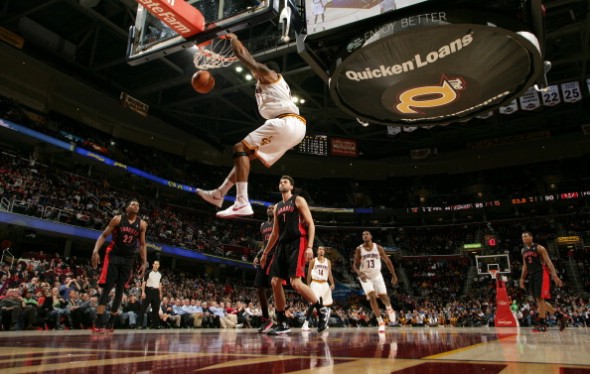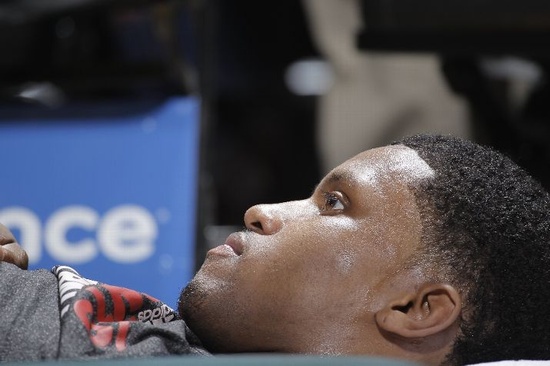This past weekend, I attended the MIT Sloan Sports Analytics Conference in Boston as one of 40-plus True Hoop Network representatives. Leaving aside just how excellent a weekend it was on a personal level (and how great Sunday’s “True Hoop Invitational” basketball was), the conference was a great learning experience for everyone who attended. Over the next few days, I’ll be writing about specific panels and research presentations that I attended, but today I just wanted to do a stream-of-consciousness style piece about analytics in the NBA.
The first thing that really came across from all of the people who spoke, which ranged from Harvard/Grantland genius Kirk Goldsberry to R.C. Buford of the Spurs to Stan Van Gundy and beyond, is that analytics does not mean stats. If I site Adjusted Statistical Plus Minus and you don’t like it, that’s completely fine. It doesn’t make either one of us any less of a basketball observer or fan. But if you watch a Raptors game and scream at Dwane Casey because he’s put Andrea Bargnani in as the lone big-man, and you KNOW Bargnani struggles in those situations, well, that’s analytic. Analytics doesn’t mean stats, it’s about trying to understand the game of basketball better. And that’s what this whole conference was about.
Yes, there were math-heavy presentations and research papers based on complicated SportVu data that the average fan can’t access. However, the people doing this research, and the teams doing it as well, aren’t trying to reinvent the wheel. Nobody is looking for a secret formula to make DeMar DeRozan play like LeBron James, or some algorithm that turns Amir Johnson into Dwight Howard. A lot of the time, analysts are looking to confirm the ideas they’ve developed by watching the games (“watching teh gamez, as anti-stat people will yell on Twitter).
A great example was Goldsberry’s paper called The Dwight Effect, which used visual tracking data to attempt to quantify interior defense. Stat geek or otherwise, most people who watch basketball can appreciate things like David Lee being a poor paint defender, Bargnani wanting in the help defense department, and Dwight keeping people out of the lane. Goldsberry aimed to quantify this, showing that Bargnani is present around very few shots (not getting to balls), while Lee gives up a ridiculous percentage at the rim. These findings aren’t groundbreaking in themselves, but what is it that we have ways of confirming our theories quantitatively.
Also, LARRY SANDERS! is a beast.
I’m really hoping that with my pieces this week, people won’t fire back with comments about stats being stupid and the usual reaction I get when I talk more analytics-heavy. The whole process of gathering data and discovering trends and inefficiencies isn’t about changing basketball from what you played in high school, it’s about understanding it better and making improvements at the margins. Analytics can’t change Jose Calderon to Kyle Lowry defensively, but they might tell you what style of two-guard or big-man or system is best to pair with him to hide his defensive shortcomings. This is a prescient example since the Raptors’ team defense has taken a step back despite their defensive personnel objectively improving, which can be frustrating and confusing. (And this isn’t to call out the Raptors in any way, just to use an example that is close to home.)
Really, if a guy like SVG is accepting of some of these elements, so should fans. That’s not to say SVG isn’t intelligent or an analytics-oriented coach, because he is extremely intelligent and does appreciate analytics. It’s just to show that even coaches and people who have been around the game for a long time appreciate these nuances. For Stan, it was when the advanced analysis showed that corner threes and shots at the rim were the best shots in the game and, lo and behold, Stan’s game plan was already based entirely around that because of their personnel.
And this kind of lead’s to my next point – a lot of the discussion this weekend focused on how to disseminate the message from the spreadsheet to the end user. For Van Gundy, it was about showing him that it backed up his conventional wisdom. For Kobe Bryant, it might be about showing him how to add another point per game to his totals. For Dwane Casey, it might be saying “look, we know you probably don’t love the idea of being forced to trot out Bargs every night, but here’s how to make the most of it.”
Coaches and GMs that were present admitted that the amount of analytics a guy is willing to listen to and the method of presenting it to him varies widely by player and coach. Just as important as the analysis, it seems, is finding ways to effectively communicate it. For me, as someone who wants to write, the goal is to include these elements in a way that isn’t too math-heavy or overwhelming. For team personnel, it’s about leveraging the competitive spirit present in each and every player and coach and hammering home that it can help them win, and here’s how and why.
Finally, the fact that coaches and players are willing to listen depending on the subject matter made me think that maybe the best way for teams to approach analytics isn’t top-down. Maybe the Raptors analytics department should be just as focused on answering questions for the coaches and players as dictating their findings to them. Maybe once Rudy Gay trusts the analytics and the personnel, he can come up with questions of his own about how to best use the space he’s so good at creating. Maybe Alan Anderson is curious about how he can possibly take any more shots at all. Maybe Dwane Casey wants to know how far off of Klay Thompson a wing can sag while still having time to recover if the pass comes directly from the left elbow to the right break. There are hundreds of tiny nuances that are present in every game and every strategy, and there are analytical tools that can really help manage them and optimize them.
For what it’s worth, the Raptors are actually pretty far ahead of the game in terms of collecting and using visual tracking data. They seem to have an intelligent and really well-respected department for this kind of stuff – it doesn’t mean a championship is on the horizon, but it means they’re being proactive and working hard for an edge where they can find one.
Anyway, there’s only so much anyone can do to foster buy-in and leverage these analytics. I know some people, no matter what, just won’t accept this stuff and I’ll be berated in the comments. That’s fine…my job as a writer is to try and spread the word in a digestible way, and I hope I’ve done that in the past and will continue to do so. For those who fight the analytics, they obviously didn’t read the early part of this piece. Nobody is reinventing the wheel, but the basketball world is beginning to make that wheel a little more round, a little more smooth, and a little more predictable.


